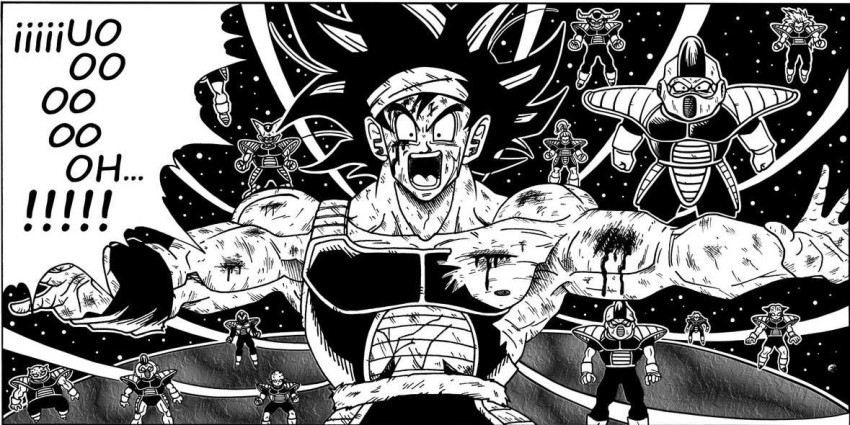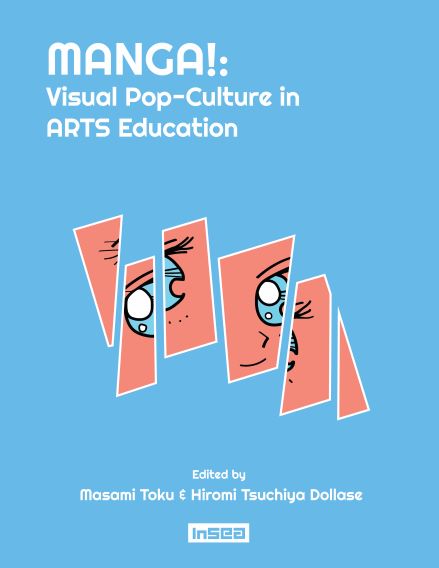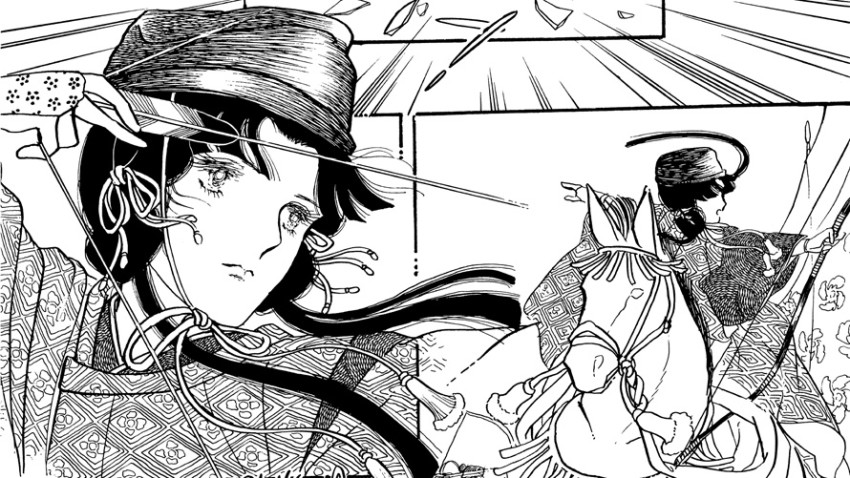Books: Manga in Arts Education
August 28, 2020 · 0 comments
By Jonathan Clements.
 Masami Toku and Hiromi Tsuchiya Dollase’s newly published Manga! Visual Pop-Culture in Arts Education is one of the most pleasant surprises of 2020, sneaked out mid-pandemic by a Portuguese foundation that is literally giving it away. It is by no means the first publication to grapple with the joys and miseries of using manga in the classroom, but does so with some impressive heavy-hitters, starting with Fusanosuke Natsume, the guru of manga studies, who provides the opening chapter.
Masami Toku and Hiromi Tsuchiya Dollase’s newly published Manga! Visual Pop-Culture in Arts Education is one of the most pleasant surprises of 2020, sneaked out mid-pandemic by a Portuguese foundation that is literally giving it away. It is by no means the first publication to grapple with the joys and miseries of using manga in the classroom, but does so with some impressive heavy-hitters, starting with Fusanosuke Natsume, the guru of manga studies, who provides the opening chapter.
Tucked at the back is a piece by CJ Suzuki about problems inherent in the way that manga is studied. He loves that manga gets taught as an element, and even as a course topic in its own right, but regards it as a growing epistemological problem that manga “belongs” to Japanese Studies. Manga, he argues, need to be read and seen, and he offers some handy tips on discussing it in the classroom. In the process of doing so, however, he concedes that manga is still “under-historicised” – in other words, a lot of people write about it without understanding it in the context of its production and reception… for which it really helps to have some grounding in Japanese Studies.
 Suzuki wants to reclaim manga as an intersectional discipline, a topic that has come up before, most notably in another free work, Japanese Media Cultures, which I recommend for anyone wading into this debate. I am sure he would certainly concede that while one doesn’t need to speak Japanese to write about manga, it really helps, otherwise we end up with howlers like those that he lists here, such as one pundit telling us that panel layout is all about gardens, or “manga style” defences, a “recent construct outside Japan”, based on an extremely blinkered understanding of what Japanese comics are. His real concern is with the way in which Area Studies wants to put the world in boxes, instead of admitting that there really are (and have always been) transnational cross-pollinations within the comics medium and beyond.
Suzuki wants to reclaim manga as an intersectional discipline, a topic that has come up before, most notably in another free work, Japanese Media Cultures, which I recommend for anyone wading into this debate. I am sure he would certainly concede that while one doesn’t need to speak Japanese to write about manga, it really helps, otherwise we end up with howlers like those that he lists here, such as one pundit telling us that panel layout is all about gardens, or “manga style” defences, a “recent construct outside Japan”, based on an extremely blinkered understanding of what Japanese comics are. His real concern is with the way in which Area Studies wants to put the world in boxes, instead of admitting that there really are (and have always been) transnational cross-pollinations within the comics medium and beyond.
There is a whole book to be written on this subject someday, for all sorts of reasons. One is that non-Japan specialists (and as is clear from this book, quite a few Japanese people) are often unaware of the political manoeuvring behind the scenes, which has led certain Japanese authorities to make grand-standing claims for manga that are not supportable. Another is that many writers on manga are so woolly and incoherent in their ability to define it that they sound like idiots. Still another is that the word manga has become such a touchstone of editorial confidence, such a killing-word of marketing power, that publishers even in academia seem to want to shove it onto any book related to Japanese media. Inevitably, this forces some contributors into shifty-eyed equivocation, presenting perfectly interesting and worthy topics, but having to name-check the word “manga” every page or so, as if it is lurking, threateningly in the room like Donald Trump looming behind Hillary Clinton at a presidential debate.
Suzuki’s chapter is a powerful and provocative piece on which to close – had Natsume not been available to supply the celebrity clout, it could just as easily serve as a strong opening chapter, since this book is an example not only of the very intersectionality that Suzuki is calling for, but also of the many pitfalls he decries. There are authors within its pages who seem to have no idea what manga is, some who think it’s Korean animation, others who think it’s any comic with big eyes, happy to make the “manga style” defence that he has just ridiculed, others keen to assign it a historical or cultural timeline that reaches so far back as to be pointless. Still others independently reach the same sort of conclusions as Suzuki himself, acknowledging that there are many possibilities for the use of manga in the classroom.
For a lot of people, such definitions don’t matter. Michael Bitz, author of Manga High, brings up a 2018 study in Ethiopia in which a bunch of teenagers were asked to draw comics. One boy cranked out a Dragon Ball pastiche on the spot, despite apparently never having even heard the word manga. He had somehow internalised the look of so many Japanese comics for young boys, from somewhere. Several other authors approach similar issues – editor Toku herself, on the development of children’s art styles (a subject she has discussed before, but here approached with much greater rigour), and Brent Wilson on the pervasive influence of Japanese mass media on the way that modern children draw. Wilson is particularly interesting on the gate-keepers of manga success – the judges of Japanese art competitions, who have the power to propel a new art-style into the public eye, or to quash it before it can be seen. Machiko Satonaka, herself a manga artist (an actual manga artist – a qualification I feel I have to add here because of the wobbliness of definition elsewhere) offers an insider’s view of both how much and how little Japanese comics artists follow the “rules” for manga that academics and judges are trying to enforce.
Far from privileging a knowledge of Japan and the Japanese, many of the chapters in this book are all about the art. Fittingly for a book on this topic, others are all about the students – Chen Hsiao-ping zooms in on three manga fans to ask what it is they get out of being fans, what it means to them, and how it has a positive affect on their life and potential educational avenues. Natsu Onoda Power playfully constructs theatrical dialogues between students arguing about race within manga – why do they all look white…? No, wait, why do you think they look white? And so on…
 Both Paola Scrolavezza and Mitsuaki Shimojo asks what it means for students if they discuss Japanese literature in manga form. Is the manga Tale of Genji any less “translated” than an English edition of the classical Japanese text, and what opportunities does it offer for discussing the subversion of the literary canon? In other words, it can aid classroom discussions in asking why we feel we have to study the Tale of Genji at all, and not something else. There are chapters here on manga and Shakespeare (Yukari Yoshihara, revisiting her work in Women’s Manga in Asia and Beyond), Mia Elise Lewis on the depiction of girls and women in manga, with special reference to a “feminist boom” from 2016 and a two chapters on teaching manga in the wake of the Fukushima disaster. In a particularly amusing chapter, not the least because it is the first academic paper I have read that cites the gleefully un-PC British sitcom Mind Your Language, Nathan Clerici examines the textbook The Japanese the Japanese Don’t Know, unpacking a discussion of what sort of Japanese should be taught in the classroom, and to what extent it should reflect the Japanese spoken in polite (or impolite) society.
Both Paola Scrolavezza and Mitsuaki Shimojo asks what it means for students if they discuss Japanese literature in manga form. Is the manga Tale of Genji any less “translated” than an English edition of the classical Japanese text, and what opportunities does it offer for discussing the subversion of the literary canon? In other words, it can aid classroom discussions in asking why we feel we have to study the Tale of Genji at all, and not something else. There are chapters here on manga and Shakespeare (Yukari Yoshihara, revisiting her work in Women’s Manga in Asia and Beyond), Mia Elise Lewis on the depiction of girls and women in manga, with special reference to a “feminist boom” from 2016 and a two chapters on teaching manga in the wake of the Fukushima disaster. In a particularly amusing chapter, not the least because it is the first academic paper I have read that cites the gleefully un-PC British sitcom Mind Your Language, Nathan Clerici examines the textbook The Japanese the Japanese Don’t Know, unpacking a discussion of what sort of Japanese should be taught in the classroom, and to what extent it should reflect the Japanese spoken in polite (or impolite) society.
In my own experience, this is a crucial topic, since many weebs have believed themselves to have learned Japanese from manga, and then proceeded to lurch around Tokyo addressing people in a ludicrous patois derived from post-apocalyptic bikers and fairy princesses. Don’t do that.
Jonathan Clements is the author of Anime: A History and has been writing the Manga Snapshot column in NEO magazine for the last fifteen years. Manga!: Visual Pop-Culture in Arts Education is published in print form and released as a free PDF by the International Society of Education Through Art (InSEA).
Leave a Reply